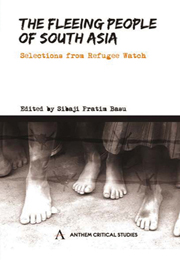Book contents
- Frontmatter
- Contents
- Acronyms and Abbreviations
- Foreword by Ranabir Samaddar
- Preface
- ETHICAL ISSUES
- LAWS
- SOUTH ASIA
- INDIA
- Introduction
- Population Displacement in India: A Critical Overview
- Reporting from Gagan Geer: A Kargil War Refugee Camp
- Barricaded Kashmiri Pandits Letting Go the Right to Return?
- Homeless and Divided in Jammu and Kashmir
- Internal Displacement in North-East India: Challenges Ahead
- The North-East Today: Displacing Identities, Displaced Identities
- Tibetan Refugees in India: Surviving in Exile
- Unrest and Displacement: Rajbanshis in North Bengal
- Adivasis in Coal Mining
- GENDER
- INTERVIEW/CORRESPONDENCE
- REPRESENTATIONS
- Index
Internal Displacement in North-East India: Challenges Ahead
from INDIA
Published online by Cambridge University Press: 05 March 2012
- Frontmatter
- Contents
- Acronyms and Abbreviations
- Foreword by Ranabir Samaddar
- Preface
- ETHICAL ISSUES
- LAWS
- SOUTH ASIA
- INDIA
- Introduction
- Population Displacement in India: A Critical Overview
- Reporting from Gagan Geer: A Kargil War Refugee Camp
- Barricaded Kashmiri Pandits Letting Go the Right to Return?
- Homeless and Divided in Jammu and Kashmir
- Internal Displacement in North-East India: Challenges Ahead
- The North-East Today: Displacing Identities, Displaced Identities
- Tibetan Refugees in India: Surviving in Exile
- Unrest and Displacement: Rajbanshis in North Bengal
- Adivasis in Coal Mining
- GENDER
- INTERVIEW/CORRESPONDENCE
- REPRESENTATIONS
- Index
Summary
Internal displacement in north-east India is a relatively new phenomenon. Until the 1970s, the north-east received huge inflows of refugees and economic migrants from neighbouring Bangladesh (erstwhile East Pakistan) and Nepal, and to a lesser extent from Burma. As a result, the demographic character of some states in the region underwent a sea change. Tripura became a Bengali majority state, leaving its indigenous tribes feeling marginalized. In Assam, Bengali Hindus and Muslims probably outnumber the ethnic Assamese now, though some doubt has been expressed about that contention. The first wave of the refugee influx, following the partition, displaced the indigenous populations from their ancestral lands. And when the indigenous groups – and militias raised by their younger people began vent their resentment through armed action against the settlers, the north-east began to wake up to large-scale internal displacement.
But the local media and administration continued to describe even the internally displaced as ‘refugees’, in spite of the fact that they did not cross over to another country. The states in India's federal polity may not enjoy as much power as the states in the US – but because Indian states or regions are so rooted in tradition and enjoy such a distinct sense of identity that they often behave like nations would, with each other. […] The internalization of the displacement, in the sense that it happened within the boundaries of the Indian nation state, has, therefore, not always resulted in an easy solution to the problems of displacement.
- Type
- Chapter
- Information
- The Fleeing People of South AsiaSelections from Refugee Watch, pp. 249 - 258Publisher: Anthem PressPrint publication year: 2009



